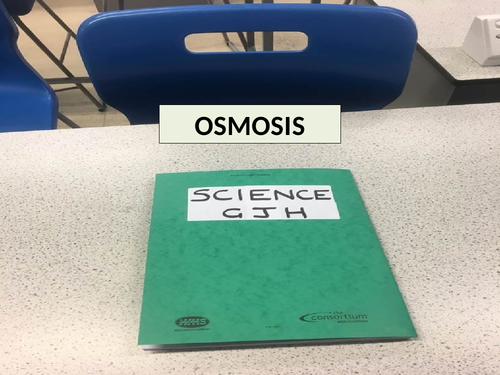Osmosis
Subject: Biology
Age range: 14-16
Resource type: Worksheet/Activity






A fully-resourced lesson that looks at the topic of osmosis and how the movement of water between a cell and the solution can affect the appearance of an animal and a plant cell. This lesson includes a detailed and engaging lesson presentation (42 slides) and differentiated worksheets that include exam questions that can be set as homework. There is a lot of key terminology associated with this topic and time is taken to ensure that students understand the meaning of each of these terms before moving forwards. Students are introduced to the different types of solutions and then a step-by-step guide is used to show them how to compare the water potential of the solution and the cell and then how this will determine which was water moves. The main task is differentiated so that students are challenged and can access the work.
This lesson has been designed for GCSE students (14 - 16 year olds in the UK) but is also suitable for A-level students
A bundle is a package of resources grouped together to teach a particular topic, or a series of lessons, in one place.
This bundle of 10 lessons covers the majority of the content in Topic B1 (Cell Biology) of the AQA Trilogy GCSE Combined Science specification. The topics covered within these lessons include: Cells Microscopy Cell differentiation and specialisation Chromosomes and mitosis Stem cells Diffusion Osmosis Active transport Exchange surfaces Exchanging substances All of these lesson presentations and accompanying resources are detailed and engaging and contain regular progress checks to allow the students to constantly assess their understanding.
This bundle of 5 lessons covers all of the content in Topic B2 (Cells) of the core and supplement sections of the Cambridge iGCSE Science Double Award specification. The topics and specification points covered within these lessons include: * Living organisms are made of cells * Structure of a plant cell and an animal cell * Functions of the organelles in animal and plant cells * Structure and function of specialised cells * Calculating magnification and size * Defining diffusion * The factors that influence the rate of diffusion * Movement through the cell membrane by diffusion * The movement of water by osmosis * The effects on plant tissues by solutions with different water potential All of these lesson presentations and accompanying resources are detailed and engaging and contain regular progress checks to allow the students to constantly assess their understanding.
This bundle of 7 lessons covers the majority of the content in Topic B1 (Key concepts in Biology) of the Edexcel GCSE Combined Science specification. The topics covered within these lessons include: Animal cells Plant cells Bacterial cells Specialised cells Changes in microscopic technology Number, size and scale The relationship between quantitative units Enzyme properties and action Enzyme activity Osmosis Active transport All of these lesson presentations and accompanying resources are detailed and engaging and contain regular progress checks to allow the students to constantly assess their understanding.
This bundle of 4 lessons covers all of the content in the sub-topic B1.3 (Transport in cells) of the AQA Trilogy GCSE Combined Science specification. The topics covered within these lessons include: * Diffusion * Examples of diffusion in organisms * Factors that affect the rate of diffusion * SA:V ratio and the need for exchange surfaces * Osmosis * Active transport All of these lesson presentations and accompanying resources are detailed and engaging and contain regular progress checks to allow the students to constantly assess their understanding.
This bundle of 3 lessons looks at the different methods by which molecules move across cell membranes. These lessons have been written for GCSE aged students, but could be used with younger students who are studying this topic and want to be challenged. Students will understand how the passive processes of diffusion and osmosis move molecules with the concentration gradient whilst active transport moves them against the gradient and therefore requires energy in the form of ATP. Time is taken to go through the factors that increase the rate of diffusion as well as relating this to the living organism with examples in the body.
This bundle of 13 lessons covers the majority of the content in Topic B2 (Scaling Up) of the OCR Gateway A GCSE Combined Science & GCSE Biology specifications. The topics covered within these lessons include: Mitosis Cell differentiation Cell specialisation Stem cells Diffusion Osmosis Active transport Exchange surfaces The heart in the circulatory system The blood and blood vessels Plant transport systems Transpiration All of these lesson presentations and accompanying resources are detailed and engaging and contain regular progress checks to allow the students to constantly assess their understanding.
This bundle of 6 lessons covers all of the content in the sub-topic B2.1 (Supplying the cell) of the OCR Gateway A GCSE Combined Science specification. The topics covered within these lessons include: * Explain how substances are transported into and out of cells through diffusion, osmosis and active transport * Describe the process of mitosis in growth, including the cell cycle * Explain the importance of cell differentiation * Describe the production of specialised cells * Recall that stem cells are present in embryonic and adult animals and in meristems in plants * Describe the functions of stem cells * Describe the difference between embryonic and adult stem cells All of these lesson presentations and accompanying resources are detailed and engaging and contain regular progress checks to allow the students to constantly assess their understanding.
Something went wrong, please try again later.
This resource hasn't been reviewed yet
To ensure quality for our reviews, only customers who have purchased this resource can review it
Report this resourceto let us know if it violates our terms and conditions.
Our customer service team will review your report and will be in touch.